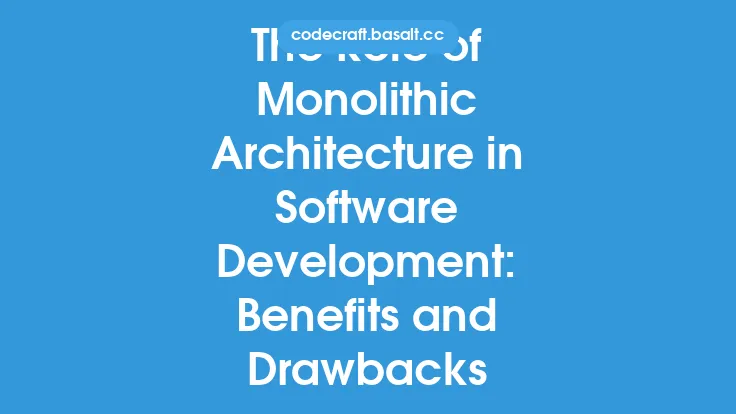When it comes to designing software systems, one of the most fundamental decisions that developers and architects face is the choice of architecture. Among the various architectural patterns, monolithic architecture is one of the most traditional and widely used approaches. In this article, we will delve into the world of monolithic architecture, exploring when to use it and why it remains a popular choice for many software projects.
Introduction to Monolithic Architecture
Monolithic architecture refers to a software design pattern where all components of an application are built into a single, self-contained unit. This means that the entire system, including the user interface, business logic, and data storage, is bundled together into a single executable or deployable unit. Monolithic architecture is often characterized by a tight coupling between components, which can make it easier to develop and test, but also more challenging to maintain and scale.
Advantages of Monolithic Architecture
Despite the rise of alternative architectural patterns, monolithic architecture still offers several advantages that make it a viable choice for many software projects. One of the primary benefits is simplicity. Monolithic architecture is often easier to understand and develop, as all components are part of a single, cohesive unit. This simplicity can also make it easier to test and debug, as developers can focus on a single codebase rather than multiple, distributed components. Additionally, monolithic architecture can be more efficient in terms of resource utilization, as all components are running in a single process, reducing the overhead of inter-process communication.
Use Cases for Monolithic Architecture
So, when should you use monolithic architecture? There are several scenarios where this approach makes sense. One common use case is for small to medium-sized applications, where the complexity of the system is relatively low. In such cases, monolithic architecture can provide a simple and efficient solution, allowing developers to focus on delivering a working product quickly. Another scenario where monolithic architecture is suitable is for applications with a well-defined, stable set of requirements. When the requirements are unlikely to change significantly over time, a monolithic architecture can provide a robust and reliable solution. Finally, monolithic architecture can be a good choice for applications that require low latency and high performance, as the tight coupling between components can reduce the overhead of communication and improve overall system responsiveness.
Technical Considerations
From a technical perspective, monolithic architecture can be implemented using a variety of programming languages and frameworks. One popular approach is to use a traditional, three-tier architecture, consisting of a presentation layer, business logic layer, and data access layer. This approach can be implemented using languages such as Java, C#, or Python, and frameworks like Spring, ASP.NET, or Django. Another approach is to use a more modern, event-driven architecture, where components communicate with each other through events and messages. This approach can be implemented using languages like Node.js, Go, or Rust, and frameworks like Express, React, or Angular.
Challenges and Limitations
While monolithic architecture offers several advantages, it also has its challenges and limitations. One of the primary concerns is scalability. As the system grows, a monolithic architecture can become increasingly difficult to scale, as all components are tightly coupled and must be scaled together. This can lead to increased resource utilization, reduced performance, and higher costs. Another challenge is maintainability. As the system evolves, a monolithic architecture can become increasingly complex, making it harder to modify and extend. This can lead to a higher risk of bugs, errors, and downtime. Finally, monolithic architecture can make it more difficult to adopt new technologies and innovations, as the entire system must be updated and redeployed.
Best Practices for Implementing Monolithic Architecture
To overcome the challenges and limitations of monolithic architecture, it's essential to follow best practices for implementation. One key practice is to keep the system modular, even if it's a single, cohesive unit. This can be achieved by using design patterns like separation of concerns, dependency injection, and interface-based programming. Another practice is to use automated testing and continuous integration, to ensure that the system is reliable, stable, and easy to maintain. Finally, it's essential to monitor and analyze the system's performance, to identify bottlenecks and areas for optimization.
Conclusion
In conclusion, monolithic architecture remains a viable choice for many software projects, offering advantages like simplicity, efficiency, and low latency. While it's not suitable for all scenarios, it can be a good fit for small to medium-sized applications, applications with stable requirements, and applications that require high performance. By understanding the technical considerations, challenges, and limitations of monolithic architecture, developers and architects can make informed decisions about when to use it and how to implement it effectively. By following best practices and using the right tools and technologies, it's possible to build robust, reliable, and maintainable monolithic systems that meet the needs of users and stakeholders.





